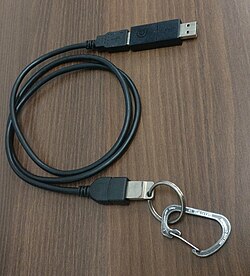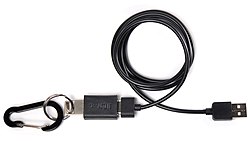BusKill
Topic: Software
 From HandWiki - Reading time: 6 min
From HandWiki - Reading time: 6 min
 | |
| Original author(s) | Michael Altfield |
|---|---|
| Developer(s) | BusKill Development Team |
| Initial release | August 2, 2020[1] |
| Stable release | v0.7.0
/ June 17, 2023 |
| Written in | Python |
| Operating system | Linux, OS X, Windows, Qubes OS[2] |
| Type | Anti-forensic |
| License | CC BY-SA, GPLv3[3] |
| Website | buskill |
BusKill is an open-source hardware and software project that designs computer kill cords to protect the confidentiality of the system's data from physical theft. The hardware designs are licensed CC BY-SA and the software is licensed GPLv3. BusKill cables are available commercially from the official website or through authorized distributors.
The name BusKill is an amalgamation of "Bus" from USB and "Kill" from kill cord.[4]
History
The first computer kill cord was built by Michael Altfield in 2017.[5][6]
The term "BusKill" was coined by Altfield in January 2020 when publishing the first BusKill build and udev usage instructions (Linux-only),[1][7][8] and it was ported by cyberkryption from Linux to Windows a couple weeks later.[9][10] The project's official website launched the following month.[11]
The first OS X version of the BusKill app was released in May 2020[12] by Steven Johnson.
A cross-platform rewrite of the software based on Kivy was released in August 2020 with support for Linux, OS X, and Windows.[13]
In December 2021, Alt Shift International OÜ ran a crowdfunding campaign to manufacture BusKill cables on Crowd Supply.[14][15][16] The campaign raised $18,507 by January 2022.[17]
Hardware
The BusKill cable is a kill cord that physically tethers a user to their computer with a USB cable.[18][19]
One end of the cable plugs into a computer. The other end of the cable is a carabiner that attaches to the user.[20]
In the middle of the cable is a magnetic breakaway coupler, to allow the cable to be safely separated at any angle without physically damaging the computer or the user.[21][22]
A 3D-printable hardware BusKill cable is currently under development.[23][24]
Software
The BusKill project maintains a cross-platform GUI app that can either lock the screen or shutdown the computer when the cable's connection to the computer is severed and the app is in the "armed" state.[18][25][26]
Use
If the computer is separated from the user, then a magnetic breakaway in the cable causes a USB hotplug removal event to execute a trigger in the app.[27]
The trigger executed by the BusKill cable's removal can lock the screen, shutdown, or securely erase the LUKS header and master encryption keys within a few seconds of the cable's separation.[28][29][30]
If combined with full disk encryption, then these triggers can be used to ensure the confidentiality of data or be used as a counter-forensics device.
See also
- Dead man's switch
- USBKill
- Tails (operating system)
- List of data-erasing software
- List of free and open-source software packages
References
- ↑ 1.0 1.1 Altfield, Michael (2020-01-02). "Introducing BusKill: A Kill Cord for your Laptop". https://tech.michaelaltfield.net/2020/01/02/buskill-laptop-kill-cord-dead-man-switch/. "This post will introduce a simple udev rule and ~$20 in USB hardware that effectively implements a kill cord Dead Man Switch to trigger your machine to self-destruct in the event that you're kicked out of the helm position."
- ↑ Altfield, Michael (2022-01-04). "A Laptop Kill Cord for QubesOS" (in English). https://www.buskill.in/qubes-os/.
- ↑ "License". BusKill. https://docs.buskill.in/buskill-app/en/stable/license.html.
- ↑ "Interview with Michael Altfield, the Mind Behind BusKill - the World's First USB Kill Cord - Dark Net Daily". https://darknetdaily.com/2021/12/05/interview-with-michael-altfield-the-mind-behind-buskill-the-worlds-first-usb-kill-cord/.
- ↑ Helen Leigh (Jan 14, 2022). Teardown Session 17: OpSec and Privacy with Michael Altfield (Video Interview). Berlin, Germany: Crowd Supply. Event occurs at 12 minutes, 35 seconds. Retrieved 2022-07-02.
I decided to build this for myself actually in 2017, and then I published the article in 2020.
- ↑ Sasidhar (January 2022). "An interview of Michael Altfield" (in English). https://thesocialtalks.com/technology/an-interview-of-michael-altfield-by-sasidhar/.
- ↑ Winder, Davey (Jan 3, 2020). "This $20 USB Cable Is A Dead Man's Switch For Your Laptop" (in English). Forbes. https://www.forbes.com/sites/daveywinder/2020/01/03/this-20-usb-cable-is-a-dead-mans-switch-for-your-linux-laptop/.
- ↑ Korben (2020-02-06). "Un câble USB pour autodétruire votre ordinateur sous Linux s'il est volé ? Voici BusKill !" (in French). :fr:Korben. https://korben.info/un-cable-usb-pour-autodetruire-votre-ordinateur-sous-linux-sil-est-vole-voici-buskill.html.
- ↑ @cyberkryption. "Here's my port of @MichaelAltfield #BusKill to windows in python" (in English). https://twitter.com/cyberkryption/status/1218622293271810048. Missing or empty |date= (help)
- ↑ "GitHub - BusKill/buskill-windows: Windows port for the BusKill Kill Cord". 4 January 2022. https://github.com/BusKill/buskill-windows.
- ↑ @BusKillin. "Due to popular demand, #BusKill now has a website!" (in English). https://twitter.com/BusKillin/status/1229349862921195520. Missing or empty |date= (help)
- ↑ "Commits · BusKill/buskill-mac · GitHub". https://github.com/BusKill/buskill-mac/commits/.
- ↑ "Commits · BusKill/buskill-app". https://github.com/BusKill/buskill-app/commits/v0.1.0.
- ↑ Nickel, Oliver (Dec 16, 2021). "Magnetisches Kabel dient als Killswitch für Notebooks" (in German). Computec. https://www.golem.de/news/buskill-magnetisches-kabel-dient-als-killswitch-fuer-notebooks-2112-161861.html.
- ↑ "ログイン中のPCが盗まれた時に強制的にPCをシャットダウンしてデータを保護してくれるUSBデバイス「BusKill」" (in Japanese). :jp:GIGAZINE. Dec 16, 2021. https://gigazine.net/news/20211216-buskill-usb-cable-pc-kill-switch/.
- ↑ "Este cable USB bloquea o destruye un ordenador para proteger los datos en caso de robo" (in Spanish). 20 minutos. Dec 17, 2021. https://www.20minutos.es/tecnologia/cable-usb-bloquea-destruye-ordenador-proteger-datos-caso-robo-4927672/.
- ↑ "BusKill". https://www.crowdsupply.com/alt-shift/buskill.
- ↑ 18.0 18.1 Michael Altfield (Jan 18, 2022). BusKill Cross-Platform Demo (v0.4.0) (Video Demo). Berlin, Germany. Event occurs at 1 minute, 5 seconds. Retrieved 2022-07-02.
- ↑ Cimpanu, Catalin (Jan 2, 2020). "New USB cable kills your Linux laptop if stolen in a public place" (in English). ZDNet. https://www.zdnet.com/article/new-usb-cable-kills-your-linux-laptop-if-stolen-in-a-public-place/.
- ↑ "Hardware User Guide" (in English). https://docs.buskill.in/buskill-app/en/stable/hardware_usr/index.html.
- ↑ "Assembly of components" (in English). https://docs.buskill.in/buskill-app/en/stable/hardware_dev/assembly.html.
- ↑ Kan, Michael (Jan 2, 2020). "Programmer's USB Cable Can Kill Laptop If Machine is Yanked Away" (in English). PCMag. https://www.pcmag.com/news/programmers-usb-cable-can-kill-laptop-if-machine-is-yanked-away.
- ↑ "Design Shell in FreeCAD". https://github.com/BusKill/usb-a-magnetic-breakaway/issues/2.
- ↑ Hill, Ash (May 2, 2023). "3D Print Your Own USB BusKill Module to Protect Data" (in English). Tom's Hardware. https://www.tomshardware.com/news/3d-printable-buskill-cable.
- ↑ Crider, Michael (Dec 17, 2021). "This USB 'dead man's switch' locks down (or kills) snatched laptops" (in English). PC World. https://www.pcworld.com/article/560619/this-usb-dead-mans-switch-cable-for-laptops-is-one-cat-tug-away-from-catastrophe.html.
- ↑ "Software User Guide" (in English). https://docs.buskill.in/buskill-app/en/stable/software_usr/gui.html#trigger-selector.
- ↑ "What is BusKill?" (in English). https://docs.buskill.in/buskill-app/en/stable/introduction/what.html.
- ↑ Altfield, Michael (Dec 28, 2021). "LUKS Header Shredder (BusKill Self-Destruct Trigger)" (in English). https://www.buskill.in/luks-self-destruct/.
- ↑ Shilov, Anton (Dec 15, 2021). "BusKill USB Cable Now Available: A PC Kill Switch for Data Protection" (in English). Tom's Hardware. https://www.tomshardware.com/news/buskill-usb-cable-now-available-a-pc-kill-switch-for-data-protection.
- ↑ Whittaker, Zack (Dec 17, 2021). "This USB 'kill cord' can instantly wipe your laptop if snatched or stolen" (in English). TechCrunch. https://techcrunch.com/2021/12/16/buskill-kill-cord-self-destruct-laptop/.
External links
 |
 KSF
KSF


